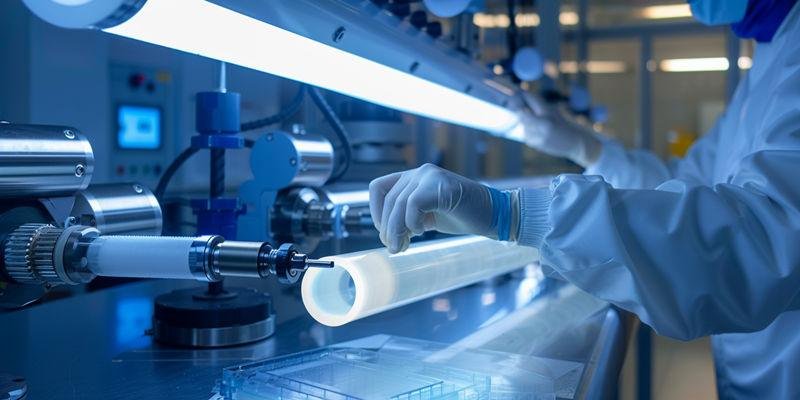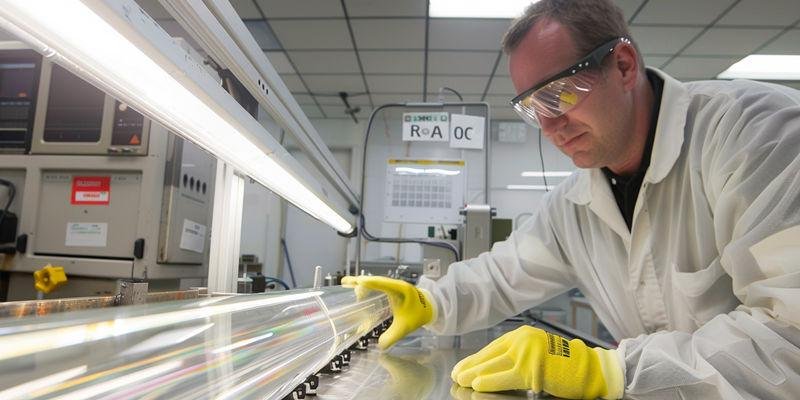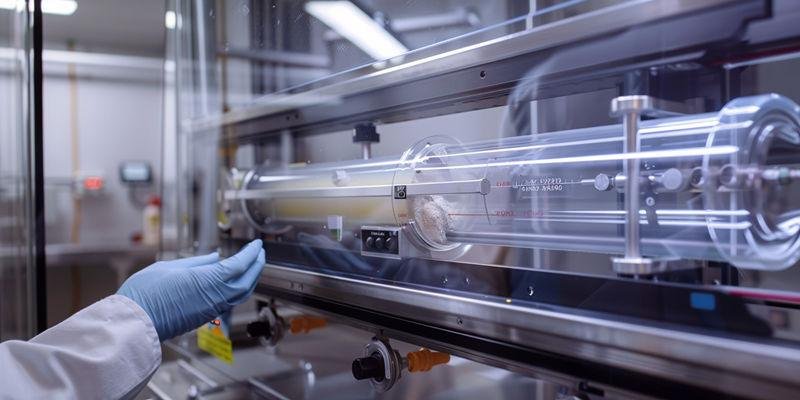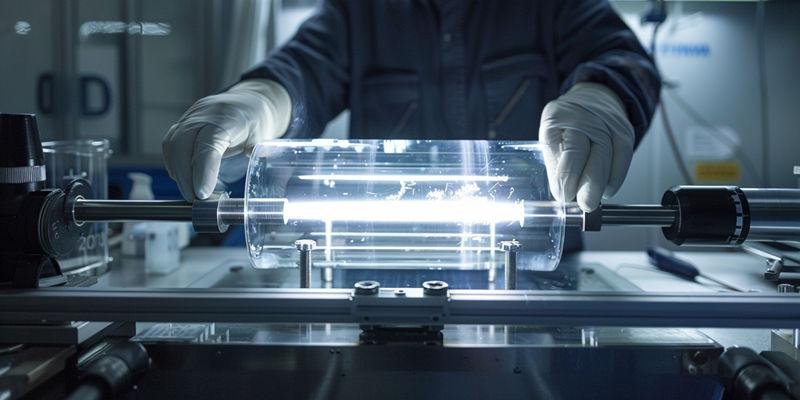Selecting the right material for demanding industrial environments requires careful consideration of performance, durability, and cost.
Quartz glass serves critical roles across semiconductor manufacturing, laboratory equipment, high-temperature processing, and optical systems due to its exceptional thermal stability, chemical purity, and optical transmission properties. Its applications span from precision optics requiring 90%+ UV transmission to furnace components operating at 1000°C+, making it indispensable for industries demanding superior performance under extreme conditions.

Quartz glass stands out for its ability to meet the rigorous demands of modern industry. The following sections explore its unique properties, industry-specific uses, and decision frameworks for optimal material selection.
What is Quartz Glass?
Understanding the fundamental nature of quartz glass is essential for appreciating its industrial value.
Quartz glass, also known as fused silica, is an amorphous form of silicon dioxide (SiO₂) renowned for its high purity and exceptional optical clarity. Its ability to transmit ultraviolet, visible, and infrared light with minimal absorption makes it vital for precision optics and photonics.

Quartz glass is produced by melting high-purity silica at temperatures above 1,700°C, resulting in a non-crystalline structure with minimal impurities. This process yields a material with outstanding optical properties, including over 90% transmission in the UV range (200–400 nm) and up to 93% in the visible spectrum. Such clarity is critical for applications like UV sterilization, laser optics, and analytical instrumentation, where even minor absorption or scattering can compromise performance.
Key Properties of Quartz Glass
| Property | Value/Range | Context/Notes |
|---|---|---|
| Chemical Composition | >99.99% SiO₂ | High-purity fused silica |
| Optical Transmission (UV, 200–400 nm) | >90% | At 1 mm thickness |
| Optical Transmission (Visible, 400–700 nm) | 92–93% | At 1 mm thickness |
| Maximum Continuous Use Temp (°C) | 1,050–1,200 | Varies by grade |
| Thermal Expansion (10⁻⁶/K) | 0.5 | At 25°C |
| Thermal Shock Resistance (ΔT, °C) | 200–250 | Rapid temperature change |
| Dielectric Strength (kV/mm) | 30–40 | Electrical insulation |
Which Industries Rely Most on Quartz Glass Applications?
Meeting the needs of advanced industries requires materials that can withstand extreme conditions and deliver consistent performance.
Industries such as semiconductors, laboratories, and photonics depend on quartz glass for its purity, durability, and optical properties. Its unique characteristics enable critical processes and innovation across these sectors.

Quartz glass is indispensable in sectors where contamination, thermal stress, and optical precision are major concerns. Its adoption is driven by the need for reliable, high-performance materials in mission-critical environments.
Industry-Specific Applications of Quartz Glass
| Industry | Typical Applications | Key Requirements |
|---|---|---|
| Semiconductor | Wafer processing tubes, boats, crucibles, windows | High purity, thermal stability |
| Laboratory/Research | Cuvettes, beakers, tubes, reaction vessels | Chemical resistance, transparency |
| Optical/Photonics | Lenses, prisms, windows, fiber optics | UV/IR transmission, low birefringence |
| Lighting | UV lamps, halogen lamp envelopes | UV transparency, heat resistance |
| Solar Energy | Photovoltaic tube covers, protective glass | UV/IR transmission, durability |
| Chemical Processing | Reactor linings, sight glasses | Chemical inertness, high temp |
Semiconductor and Electronics Manufacturing
The semiconductor industry demands materials that can withstand high temperatures and maintain purity during wafer fabrication.
Quartz glass is used for furnace tubes, boats, and crucibles in processes such as oxidation, diffusion, and CVD. Its low thermal expansion and high purity prevent contamination and ensure dimensional stability, which is critical for device yield and reliability.
Laboratory and Research Equipment
Laboratories require materials that resist chemical attack and provide accurate optical measurements.
Quartz glass is the material of choice for cuvettes, beakers, and reaction vessels exposed to aggressive acids, bases, and solvents. Its transparency enables precise spectrophotometric analysis, while its inertness ensures no interference with sensitive reactions.
Optical and Photonics Systems
Optical systems rely on materials with high transmission and minimal distortion.
Quartz glass is used in lenses, prisms, and windows for lasers, spectrometers, and analytical instruments. Its ability to transmit deep UV and IR wavelengths, combined with low birefringence, makes it essential for high-precision optical assemblies.
What High-Temperature Applications Require Quartz Glass Performance?
Operating at elevated temperatures places extraordinary demands on material stability and longevity.
Quartz glass is uniquely suited for high-temperature environments, including industrial furnaces and chemical reactors, where other materials may fail due to thermal shock or deformation.
Its low thermal expansion and high softening point (1,730°C) enable quartz glass to maintain structural integrity during rapid heating and cooling cycles, reducing the risk of cracking or failure.
High-Temperature Applications of Quartz Glass
| Application Area | Typical Components | Operating Temp (°C) | Key Performance Criteria |
|---|---|---|---|
| Industrial Furnaces | Tubes, windows, crucibles | 1,000–1,200 | Thermal shock resistance, purity |
| Chemical Reactors | Linings, sight glasses | 800–1,200 | Chemical inertness, durability |
| UV Sterilization | Lamp envelopes | 200–800 | UV transmission, heat resistance |
| Metallurgy | Casting molds, crucibles | 1,100–1,500 | High temp stability, non-reactive |
Industrial Furnace Components
Industrial furnaces require materials that can withstand repeated thermal cycling and exposure to corrosive atmospheres.
Quartz glass tubes and windows are used in furnace heating zones, providing both thermal insulation and process visibility. Their resistance to devitrification and thermal shock ensures long service life, minimizing maintenance and downtime.
High-Temperature Chemical Processing
Chemical processing at elevated temperatures demands materials that resist both heat and aggressive chemicals.
Quartz glass linings and sight glasses are employed in reactors handling acids, alkalis, and oxidizers at high temperatures. Their inertness prevents contamination and degradation, supporting consistent process yields.
How Does Chemical Resistance Make Quartz Glass Essential for Labs?
Laboratory environments often involve exposure to highly reactive chemicals and require materials that do not interfere with analytical results.
Quartz glass is highly resistant to most acids, bases, and solvents, except hydrofluoric acid. This chemical inertness ensures that it does not leach contaminants or react with samples, making it indispensable for analytical and preparative work.
Its non-porous surface and high purity further reduce the risk of sample contamination, supporting accurate and reproducible results in sensitive experiments.
Chemical Resistance Comparison
| Substance | Quartz Glass Resistance | Borosilicate Glass Resistance | Notes |
|---|---|---|---|
| Hydrochloric Acid | Excellent | Good | Both suitable |
| Sulfuric Acid | Excellent | Good | Quartz superior at high temp |
| Hydrofluoric Acid | Poor | Poor | Both attacked |
| Sodium Hydroxide | Good | Moderate | Quartz more resistant |
| Organic Solvents | Excellent | Excellent | Both suitable |
| Oxidizing Agents | Excellent | Good | Quartz preferred for purity |
What Optical Applications Benefit from Quartz Glass Transmission?
Precision optical applications demand materials with high transmission across a broad wavelength range.
Quartz glass is prized for its ability to transmit ultraviolet, visible, and infrared light with minimal absorption or distortion. This makes it the preferred material for UV optics, laser windows, and analytical instrumentation.
Its low birefringence and high homogeneity further enhance image quality and measurement accuracy in demanding optical systems.
Optical Transmission Performance
| Application | Wavelength Range (nm) | Quartz Glass Transmission (%) | Key Benefit |
|---|---|---|---|
| UV Spectroscopy | 200–400 | >90 | Deep UV analysis |
| Laser Optics | 250–2,500 | 85–93 | Low absorption, high power |
| IR Windows | 2,500–3,500 | 80–85 | Thermal imaging, sensors |
| Analytical Cuvettes | 200–800 | >90 | Accurate photometric readings |
Why Choose Quartz Glass For Semiconductor Manufacturing?
Semiconductor manufacturing involves processes that are highly sensitive to contamination and thermal instability.
Quartz glass is selected when processes require high purity, resistance to thermal shock, and dimensional stability at elevated temperatures. Typical scenarios include oxidation, diffusion, and CVD, where even trace impurities can impact device performance.
The decision to use quartz glass is often based on the number of thermal cycles, required cleanliness, and the risk of process contamination.
Semiconductor Application Criteria
| Process Step | Quartz Glass Role | Key Selection Criteria |
|---|---|---|
| Wafer Oxidation | Furnace tubes, boats | High purity, thermal stability |
| Diffusion | Reaction tubes, liners | Low contamination, durability |
| CVD | Reactor chambers | Chemical inertness, temp resistance |
| Etching/Cleaning | Sample holders, windows | Acid resistance, transparency |
What Factors Determine the Best Glass Type for Your Application?
Selecting the optimal glass type requires evaluating multiple technical and commercial factors.
Key considerations include operating temperature, chemical exposure, optical requirements, mechanical stress, and budget constraints. Each factor influences the suitability and lifecycle cost of the chosen material.

A systematic approach ensures that the selected glass meets both performance and economic objectives.
Glass Selection Criteria
| Factor | Quartz Glass Advantage | When to Choose Quartz Glass |
|---|---|---|
| High Operating Temp | Yes | >500°C, frequent thermal cycling |
| UV/IR Transmission | Yes | UV analysis, laser optics |
| Chemical Inertness | Yes | Strong acids, oxidizers, purity needed |
| Mechanical Strength | Moderate | Not for high-impact loads |
| Cost Sensitivity | No | When performance outweighs cost |
| Custom Fabrication | Yes | Complex shapes, tight tolerances |
What Cost Factors Affect Quartz Glass Procurement Decisions?
Procurement decisions must balance initial investment with long-term value and risk mitigation.
Quartz glass typically costs 3–5 times more than standard glass, but its durability and performance can reduce total lifecycle costs by minimizing replacements and downtime. Key cost drivers include material grade, fabrication complexity, order volume, and quality certification requirements.

Understanding these factors enables more accurate budgeting and supplier negotiations.
Quartz Glass Procurement Cost Breakdown
| Cost Component | Typical Share (%) | Notes |
|---|---|---|
| Raw Material (SiO₂) | 30–40 | Purity level impacts price |
| Fabrication/Labor | 25–35 | Custom shapes increase cost |
| Quality Inspection | 10–15 | Certification, testing |
| Logistics/Shipping | 10–20 | Export, packaging, insurance |
| Overhead/Other | 5–10 | Documentation, compliance |
What Quality Parameters Guide Quartz Glass Selection for Specific Applications?
Adhering to recognized quality standards ensures product reliability and regulatory compliance.
Quartz glass products are typically evaluated against international standards such as ISO 9001 (quality management), ASTM E438 (laboratory glassware), and SEMI standards for semiconductor applications. These standards define requirements for purity, dimensional accuracy, and performance testing.
Specifying compliance with relevant standards during procurement reduces the risk of quality issues and ensures compatibility with downstream processes.
Major Quality Standards for Quartz Glass
| Standard | Scope/Industry | Key Requirements |
|---|---|---|
| ISO 9001 | All industries | Quality management system |
| ASTM E438 | Laboratory glassware | Chemical resistance, dimensional tolerances |
| SEMI PV/SE | Semiconductor, solar | Purity, surface finish, trace metals |
| RoHS/REACH | Electronics, EU market | Hazardous substance limits |
How Do You Evaluate Suppliers for Custom Quartz Glass Components?
Choosing the right supplier is critical for ensuring product quality, timely delivery, and technical support.
Key evaluation criteria include manufacturing capabilities, quality control processes, engineering support, lead times, and after-sales service. Site audits, sample testing, and reference checks are recommended for high-value or custom orders.
A structured supplier assessment reduces procurement risks and supports long-term partnerships.
Supplier Evaluation Criteria
| Evaluation Factor | Key Questions/Indicators | Importance Level |
|---|---|---|
| Manufacturing Capability | In-house fabrication, CNC, custom shapes? | High |
| Quality Control | ISO/ASTM/SEMI certifications, inspection reports? | High |
| Engineering Support | Design assistance, drawing review? | Medium |
| Lead Time/Delivery | Stock availability, expedited shipping? | High |
| Minimum Order Quantity | Small batch acceptance? | Medium |
| After-Sales Service | Warranty, technical support? | Medium |
| Export Experience | International logistics, documentation? | Medium |
Decision Framework for Selecting Quartz Glass Applications
Making an informed material selection requires a stepwise evaluation of application needs, performance criteria, and commercial constraints.
The following checklist guides users through the key decision points for choosing quartz glass over alternative materials.
Application Selection Checklist
| Step | Key Question | Recommended Action if "Yes" |
|---|---|---|
| 1 | Will the component face >500°C or rapid cycling? | Prioritize quartz glass for thermal stability |
| 2 | Is UV/IR transmission critical to performance? | Select quartz glass for optical clarity |
| 3 | Will the part contact strong acids/oxidizers? | Use quartz glass for chemical inertness |
| 4 | Is product purity or contamination a concern? | Specify high-purity quartz glass |
| 5 | Is custom geometry or tight tolerance required? | Engage suppliers with advanced fabrication |
| 6 | Is lifecycle cost more important than upfront price? | Calculate ROI for quartz glass investment |
Conclusion
Quartz glass is indispensable for industries requiring high purity, thermal stability, and optical performance.
Navigating the complexities of industrial material selection requires expert guidance. Leverage our factory-direct supply and engineering support, backed by 20+ years of experience, to optimize your custom quartz glass solutions—contact us for a tailored consultation.
FAQ (Frequently Asked Questions)
What is the typical lead time for custom quartz glass components?
Lead times vary by complexity and order volume, but standard items can ship within 24–72 hours, while custom parts may require 2–4 weeks for fabrication and quality inspection.
How do I verify the quality of quartz glass before procurement?
Request material certificates, dimensional inspection reports, and compliance documentation (such as ISO or ASTM standards) from your supplier. Sample testing is recommended for critical applications.
Can quartz glass be machined or shaped after production?
Yes, quartz glass can be cut, drilled, and polished using specialized equipment. However, post-processing requires expertise to avoid microcracks and maintain dimensional accuracy.
What are the risks of choosing standard glass over quartz glass for high-temperature use?
Standard glass is prone to thermal shock failure and contamination at elevated temperatures, leading to higher replacement costs and process downtime compared to quartz glass.





